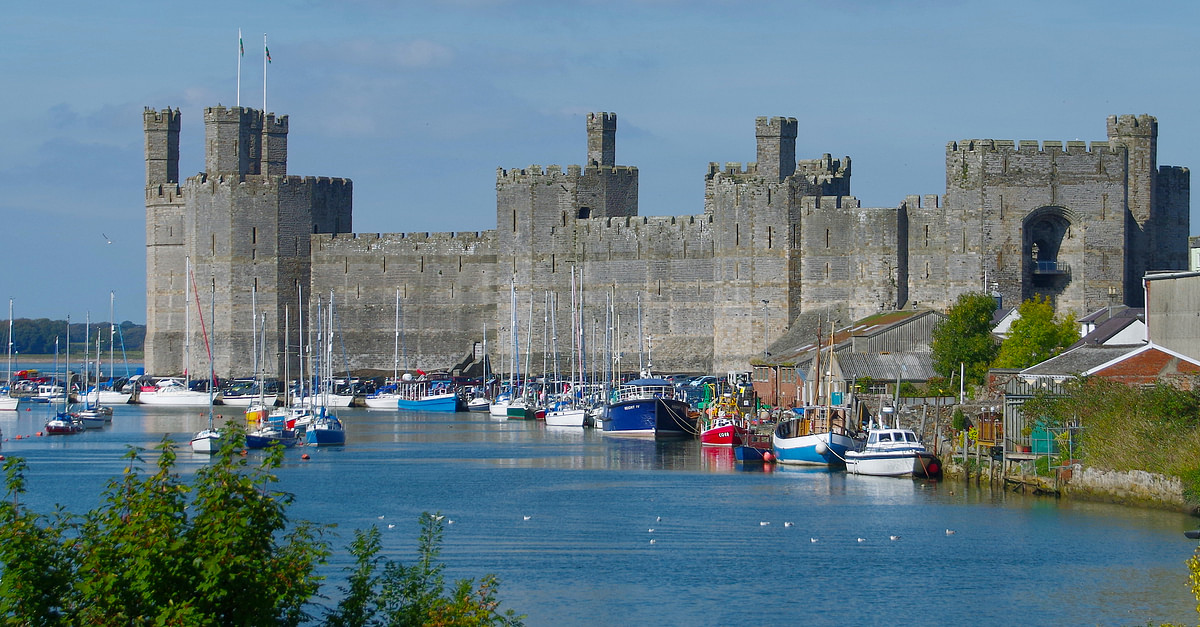Around Caernarfon DINAS DINLLE 3 miles S of Caernarfon off the A499 A Fort St David A Fort Williamsburg C Dinas Dinlle Fort Dinas Dinlle is...
Around Caernarfon DINAS DINLLE 3 miles S of Caernarfon off the A499 A Fort St David A Fort Williamsburg C Dinas Dinlle Fort Dinas Dinlle is a seaside village at the mouth of the Menai Strait. With a shingle beach and cliffs overlooking Caernarfon Bay, there are many pleasant spots to picnic and enjoy the views down the Llyn Peninsula or across the bay to Anglesey.
At the beach’s northerly tip at Belan lies Fort St David, which was built in the 18th century along with Fort Williamsburg at Glynllivon. It was constructed by the first Lord Newborough, who felt concern over the threat of invasion by Napoleon;
he also raised and equipped his own private army, The Royal Caernarfonshire Grenadiers, which, by the time of his death in 1807, had cost him a quarter of his fortune. Dinas Dinlle Fort, overlooking she shore, is much older, as it dates from the Iron Age.
LLANDWROG 4 miles S of Caernarfon off the A499 A Parish Church of St Tyrog Llandwrog was built to serve the estate of Lord Newborough at Glynllifon Park, and memorials to the Newborough family may be seen in the Parish Church of St Tyrog.
CLYNNOG FAWR 10 miles SW of Caernarfon on the A499 A Parish Church of St Beuno C St Beuno’s Well C Bachwen This typical Llyn Peninsula village on the Heritage Coast is famous for its remarkably large and beautiful Parish Church of St Beuno, which stands on the site of a chapel founded by the saint around AD616. One of the sons of the royal family of Morgannwg, St Beuno had great influence in North Wales, and he built his chapel on land that was presented to him by Cadwallon, King of Gwynedd.
St Beuno’s burial place and his shrine can be seen in this early 16th-century building, which lies on the Pilgrims’ Route to Bardsey Island. For many years, his tomb was thought to have curative powers. Nearby is St Beuno’s Well, whose waters were also thought to cure all manner of illness and conditions, especially if the sufferer had first visited the church. Close by, and virtually on the seafront, stands the capstone and three uprights of Bachwen, a Neolithic burial chamber.
Y FELINHELI 4 miles NE of Caernarfon off the A487 D The Greenwood Centre D Glan Faenol Situated south of this village is The 26Guide to Rural Wales NORTH WALES COAST AND ISLE OF ANGLESEY F stories and anecdotes G famous people H art and craft I entertainment and sport J walks A historic building B museum and heritage C historic site D scenic attraction E flora and fauna Looking for somewhere to stay, eat, drink or shop?
www.findsomewhere.co.uk Greenwood Centre, a forest heritage and adventure park. Opened in the early 1990s, this centre concentrates on exploring and explaining man’s relationship with trees and how, by using conservation techniques, the loss of trees from the countryside can be halted whether in the equatorial rain forests or ancient temperate forests of Europe. The skills of ancient carpenters and joiners are also on show, particularly in the Great Hall. This building was constructed entirely using medieval skills and knowledge and is held together by 500 oak pegs! A couple of miles further east off the A487, bordering the Menai Strait, is Glan Faenol (NT),
which includes parkland and farmland around Vaynol Hall, once one of the largest estates in North Wales. This is an important habitat for wildlife, and a pleasant walk leads to the sea and two viewing platforms. The estate has tracts of ancient woodland and several follies, including one built to rival the Marquess Column on Anglesey. The views of Snowdonia and across the strait are memorably depicted in one of Rex Whistler murals at Plas Newydd.
mainland Wales. The waterfront is a popular place for anglers and for those wishing to view the annual Regatta on the Menai Strait held every August, as well as for the promenade, known as the Belgian Promenade because it was built by refugees from Belgium who sought shelter here during World War I. On Church Island, reached by a causeway from the town,
there is the 14th-century St Tysilio’s Church, built on the site of a foundation by St Tysilio in AD630. The site is thought to have been visited by Archbishop Baldwin and Giraldus when they may have landed here in 1188. It can be reached by a short causeway from the Belgian Promenade. For a place with a difference, Pili Palas (Butterfly Palace) is an interesting and unusual attraction that will delight everyone.
The vast collection of exotic butterflies and birds, from all over the world, can be seen in tropical environments, where visitors can marvel at the colourful creatures and see the wonderful tropical plants. There is also a Tropical Hide, an amazing Ant Avenue and a Snake House, and while adults relax in Pili Palas’ café, children can let off steam in the adventure play area.


No comments